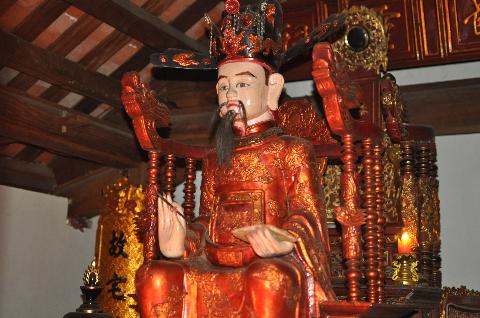Temple of Literature is one of the most interesing destinations in Hanoi city tour. Join us to learn about the three kings are worshiped at the Temple of literature.
Văn Miếu Quốc Tử Giám is one of the most important historical and cultural sites of Vietnam. The Thái Học courtyard was constructed on the former ground of Quốc Tử Giám in 2000 to honor 3 Vietnamese kings:
- Lý Thánh Tông who founded Văn Miếu in 1070.
- Lý Nhân Tông who founded Quốc Tử Giám (The first National University) in 1076.
- Lê Thánh Tông who ordered the erction of the first doctor's stone stelae in 1484.
LÝ THÁNH TÔNG (1023-1072).
Ly Thanh Tong King
King Lý Thánh Tông was a native of Cổ Pháp district, which now belongs to Đình Bảng commune, Tiên Sơn distric, Bắc Ninh province. His forbidden name was Nhật Tôn and he was prince ofKing Lý Thái Tông. In 1028 he became Đông Cung Crown Prince. When King Lý Thái Tông passed away he took the throne and his reign lasted 18 years (1054-1072).
He was a wise and charitable king, set forth wise directions to build a powerful country such as decreasing punishments, attaching importance to farming, developing education, consolidating and strengthening the national defense from the north to the south.
In 1070 he ordered the erection of Văn Miếu (Temple of Literature) to worship Confucius, sages, Confucian scholars. The Crown Prince Lý Càn Đức studied here.
LÝ NHÂN TÔNG (1066-1128).

Ly Nhan Tong King
His given name Càn Đức. He was the first son of King Lý Thánh Tông and Queen Ỷ Lan.
At the age of seven he became king and ruled for the next 56 years (1072-1128). He was a brilliant, humanitarian, knowledgeable king. He was also good at music, composition, and military. He succeeded in defeating enemies from the north anh the south. He concerned about farm work, forbade the killing of cows and buffalos, so he was supported by all mandarins and people with all their hearts.
In 1075 he held the Minh Kinh Bác Học exam, which was the first exam in Việt Nam history. In 1076 he ordered the building of Quốc Tử Giám (the first National University) setting up the foundation for development of Confucianism in Việt Nam, making great contributions to the construction of national culture.
LÊ THÁNH TÔNG (1442-1497).

Le Thanh Tong King
His given name is Hạo, his pen name is Tư Thành. He was the fourth son of King Lê Thái Tông. He was he king for 37 years (1460-1497), and gave 2 reign titles: Quang Thuận and Hồng Đức. He was a clear-sighted, decisive king. He was also both a talented scholar and a warrior.
Under his rule, Đại Việt country was independent, united and powerful: the culture and education highly developed. He was a great reformer: reformed government structure, gave prominence to jurisdiction, promulgated the Hồng Đức law, ordered to make the map Hồng Đức – the first map of Đại Việt country. He ordered to reconstruct Văn Miếu and enlarge Quốc Tử Giám in 1483 into the spacious architectural complex, developed Confucian education and examination, ordered the National examination held every three years. He was also the King was ordered to erect the first doctor stelae in Văn Miếu to honour the talent and encourage students to learn Confucianism to have names recorded in the golden board in Thái Học house.
Lê Thái Tông was a poet he founded the Tam Đàn association, vindicaded Nguyễn Trãi and collected his remains. He ordered also to revise many geat historic works such as: Đại Việt sử ký toàn thư, Thiên Nam dư hạ tập…


